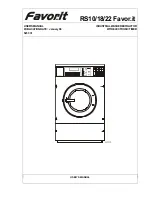
EN
CoMBuSTIon ChaMBER GaS hEaTED InSTRuCTIonS-REGulaTIonS
DiBO 32
9
11. Requirements for starting
11.1 Fundamental requirements
electrical voltage [230 V / 50 Hz ( 110 V / 50 / 60 Hz )].
sufficient quantity of water ( > 6 ltr. / min).
sufficient water pressure ( high pressure range > 20 bar )
( low pressure range > 4 bar flow pressure )
unlocked temperature limiting safety device.
(digital)thermostat, adjusted to the desired water temperature.
If these prerequisites are accomplished, the green control light at the front of the switch box should be “on”.
If not, each item has to be checked.
11.2 Fundamental requirements for starting concerning the gas
At the entrance of the valve a gas pressure of at least 20 mbar must exist. (ball valve open and pressure measuring
at point 1 see picture 3 on page 11)
After the starting of the ventilator the air pressure must be > 2 mbar.
If not, check the ventilator motor, the ventilator entrance and the measuring hose.
11.3 Requirements for a stable flame.
Sufficient ionization current > 3 µ A.
For the measurement the plug of the ionization electrode has to be pulled off, and a micro ammeter has to be looped in.
The measuring has to be done during the starting period and during the operation of the burner.
If the ionization current is too low or not existing at all, verify the plug, the cable and the ionization electrode.
If necessary, readjust the electrode. In difficult situation you could retrofit a UV-cell.
12. Putting into operation
12.1 Guarantee the water supply
Open the water tap, start the pump,
Attention – to avoid the formation of steam bubbles at full loading of the burner, the water quantity may not fall below
6 Litres/min.!
12.2 Electrical connection
Verify, whether the correct tension exists at the machine.
Operating voltage: 230V / 50 Hz (110V / 50 / 60 Hz)
12.3 Gas connection
Verify, whether the ball valve is open and gas is there.
The gas pressure must be between 20 and 100 mbar.
12.4 Cold water operation
In case of cold water operation the main switch is “ON” and the thermostat is “0”.
Or boiler off switch if a digital thermostat is installed.
12.5 Hot water operation
In case of hot water operation the main switch is “ON” and the thermostat regulated according to the required temperature.
12.6 Use of chemical substances
Cleaning processes by using chemical substances require the according special devices.
If these exist, the chemical tank must be filled and the chemical’s metering valve must be opened.
Attention – if the chemical tank is empty and the metering valve is open, pressure will not build up.
If the pump runs for a longer period of time in this condition, this might lead to damages to the pump by cavitations!
12.7 Verification before each starting
Before putting into operation the machine the temperature limiting safety device, spraying device, pumps and hose
conduits should be checked as to their proper condition.
Summary of Contents for SBH-G-D
Page 2: ......
Page 4: ......
Page 54: ...NL Brander BR1000G instructies en voorschriften DiBO 54 31...
Page 55: ...Brander BR1000G instructies en voorschriften NL DiBO 55 32...
Page 56: ...NL Brander BR1000G instructies en voorschriften DiBO 56 33...
Page 57: ...Brander BR1000G instructies en voorschriften NL DiBO 57 34...
Page 66: ......
Page 68: ......
Page 98: ......
Page 100: ......
Page 150: ...EN Combustion chamber gas heated instructions regulations DiBO 54 31...
Page 151: ...Combustion chamber gas heated instructions regulations EN DiBO 55 32...
Page 152: ...EN Combustion chamber gas heated instructions regulations DiBO 56 33...
Page 153: ...Combustion chamber gas heated instructions regulations EN DiBO 57 34...
Page 162: ......
Page 164: ......
Page 206: ...DE Brennerkammer BR1000G Anweisungen Vorschriften DiBO 46 23 30 Schaltplan BR1000G...
Page 214: ...DE Brennerkammer BR1000G Anweisungen Vorschriften DiBO 54 31...
Page 215: ...Brennerkammer BR1000G Anweisungen Vorschriften DE DiBO 55 32...
Page 216: ...DE Brennerkammer BR1000G Anweisungen Vorschriften DiBO 56 33...
Page 217: ...Brennerkammer BR1000G Anweisungen Vorschriften DE DiBO 57 34...
















































